SpartanNash Bundle
How Does SpartanNash Thrive in the Food Industry?
Ever wondered how food gets from the supplier to your table, especially in a vast country like the United States? SpartanNash Company is a key player in this complex process, but how exactly does it operate? This exploration dives into the inner workings of SpartanNash, a significant force in North American food distribution and retail.
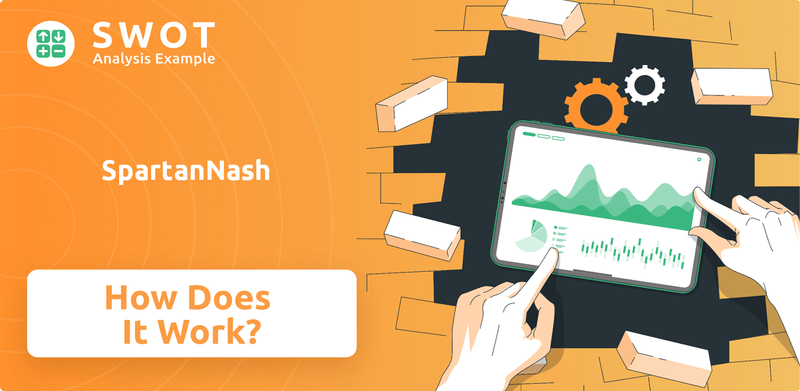
By understanding SpartanNash SWOT Analysis and its operations, investors can gain valuable insights into its financial performance and growth potential. This analysis will uncover the intricacies of SpartanNash's business model, from its extensive distribution network and grocery stores to its strategic partnerships. Learn how SpartanNash delivers food and maintains its competitive edge in a dynamic market, making it a compelling subject for anyone interested in the food supply chain and the company's future.
What Are the Key Operations Driving SpartanNash’s Success?
The SpartanNash Company creates value through its integrated approach to food distribution and retail. The company's core operations involve a wide range of grocery products, from fresh produce to specialty items, serving independent grocery stores, national chains, and military commissaries. Its retail segment operates a portfolio of grocery stores, providing direct access to consumers. Understanding how SpartanNash works involves examining its multifaceted business model.
The operational processes are extensive, encompassing procurement, warehousing, logistics, and supply chain management. SpartanNash's supply chain is a key differentiator, utilizing a vast network of distribution centers and transportation assets. This enables efficient delivery across diverse geographic regions, making it a significant player in the food distribution sector. The company's ability to manage both wholesale distribution and retail operations sets it apart.
The company's partnerships with thousands of suppliers and its robust distribution networks are central to its ability to meet diverse customer needs. This dual focus allows for synergies and economies of scale. This integrated model enables the company to optimize inventory management, reduce transportation costs, and respond rapidly to market demands. Its core capabilities translate into significant customer benefits, such as reliable product availability, competitive pricing, and tailored supply chain solutions, solidifying its market differentiation.
The core operations of SpartanNash involve both wholesale food distribution and retail grocery stores. They manage a vast supply chain, ensuring products reach various customers, including independent grocers, national chains, and military commissaries. The company's distribution network is a key component of its operations.
The value proposition of SpartanNash lies in its integrated business model, which offers reliable product availability, competitive pricing, and tailored supply chain solutions. This approach creates efficiencies and cost savings, benefiting both its wholesale and retail customers. The company's focus on efficiency and customer service is central to its value.
The company leverages an extensive network of distribution centers and transportation assets to ensure timely and efficient delivery of products. This network supports its wholesale distribution operations, allowing it to serve a wide range of customers across different geographic regions. The efficiency of this network is crucial to the company's success.
SpartanNash operates a portfolio of grocery stores, providing direct access to consumers. This retail segment allows the company to understand consumer needs and preferences, which informs its overall business strategy. Its retail presence complements its wholesale operations.
SpartanNash's unique approach is its integrated model, combining wholesale distribution and retail operations. This integration allows for better inventory management and cost efficiencies. The company's focus on supply chain optimization and customer service sets it apart.
- Dual Focus: Combining wholesale distribution and retail.
- Supply Chain: Efficient distribution network.
- Customer Benefits: Reliable product availability and competitive pricing.
- Market Position: Strong position in food distribution and retail.
SpartanNash SWOT Analysis
- Complete SWOT Breakdown
- Fully Customizable
- Editable in Excel & Word
- Professional Formatting
- Investor-Ready Format
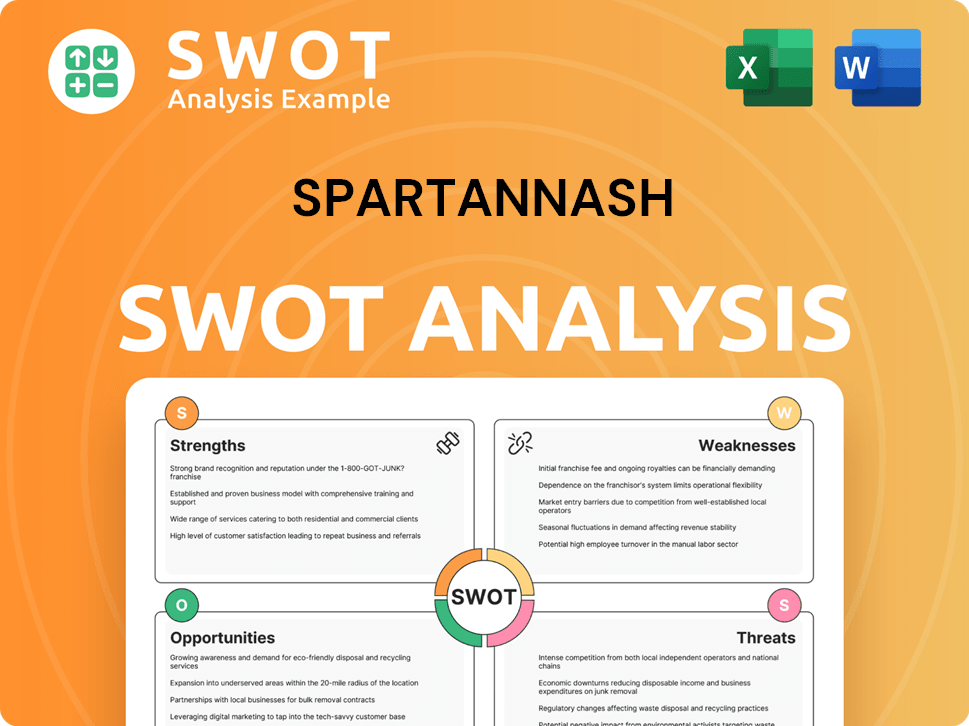
How Does SpartanNash Make Money?
Understanding the revenue streams and monetization strategies of the SpartanNash Company is crucial for grasping its operational dynamics. The company strategically diversifies its income through multiple segments, ensuring a resilient financial model. This diversification allows SpartanNash to cater to a broad market, including independent retailers, consumers, and the military.
SpartanNash's business model is built on a foundation of diverse revenue sources. The company's ability to effectively manage these varied income streams is key to its overall financial health and strategic growth. The interplay between its distribution, retail, and military segments demonstrates a well-rounded approach to market engagement.
The company's primary revenue streams include Food Distribution, Retail, and Military segments. Each segment contributes uniquely to the overall financial performance of SpartanNash. These segments are supported by various monetization strategies designed to maximize profitability and market presence.
The Food Distribution segment is a significant revenue driver, supplying grocery products to independent retailers and national accounts. SpartanNash uses volume-based pricing to generate revenue in this area. The Retail segment, encompassing its owned grocery stores, generates revenue through direct consumer sales, employing competitive pricing strategies. The Military segment focuses on supplying grocery products to military commissaries and exchanges, providing a consistent revenue stream through contract-based agreements.
- Food Distribution: This segment historically constitutes a major portion of SpartanNash's revenue, with the company distributing a wide array of products.
- Retail: Revenue is generated through sales at the company-owned grocery stores, with pricing strategies designed to attract and retain customers.
- Military: SpartanNash supplies grocery products to military commissaries and exchanges globally, operating under specific contract terms.
- Monetization Strategies: SpartanNash employs volume-based pricing, competitive retail pricing, and contract-based agreements to maximize revenue across its segments.
- Cross-Selling: The company leverages cross-selling opportunities between its distribution and retail arms, offering comprehensive solutions to its partners.
- Strategic Initiatives: Acquisitions and private label expansions are key strategies to enhance margins and customer loyalty.
SpartanNash PESTLE Analysis
- Covers All 6 PESTLE Categories
- No Research Needed – Save Hours of Work
- Built by Experts, Trusted by Consultants
- Instant Download, Ready to Use
- 100% Editable, Fully Customizable
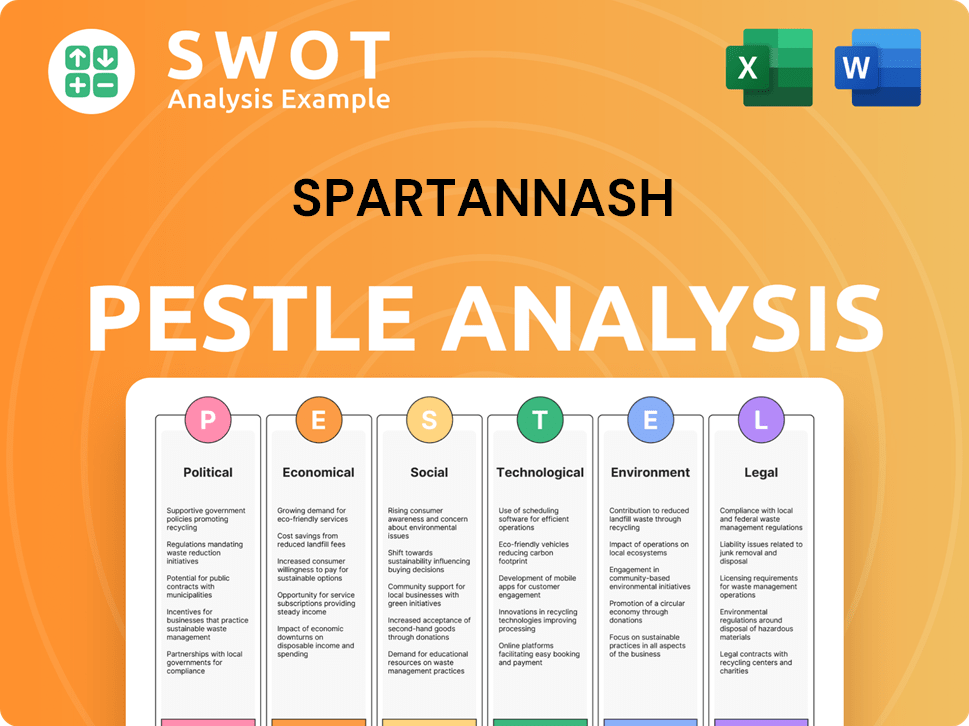
Which Strategic Decisions Have Shaped SpartanNash’s Business Model?
Understanding the inner workings of the SpartanNash Company involves examining its key milestones, strategic moves, and competitive advantages. The company has established itself as a significant player in the food distribution and retail sectors. Its operations are multifaceted, encompassing grocery distribution, retail operations, and services to the U.S. military. The company's evolution reflects its adaptability and strategic vision.
SpartanNash has consistently undertaken strategic initiatives to enhance its market position. These include acquisitions, investments in its supply chain, and efforts to meet evolving consumer demands. The company's ability to navigate challenges, such as those presented by the COVID-19 pandemic, underscores its resilience and operational flexibility. This adaptability is critical in the dynamic food industry.
How SpartanNash Works is best understood by looking at its core business functions and strategic decisions. The company's success is rooted in its extensive distribution network, strong relationships with retailers, and its role as a key supplier to the U.S. military. These components, combined with a commitment to operational excellence, have shaped its competitive edge. For a deeper dive into the specific consumer groups, consider exploring the Target Market of SpartanNash.
Significant milestones for SpartanNash include the acquisition of Martin's Super Markets in 2019, which expanded its retail footprint. Continuous investments in supply chain infrastructure and technology have also been critical. These moves have enhanced efficiency and responsiveness.
Strategic moves include adapting logistics and sourcing strategies during the pandemic. The company focuses on digital capabilities and expanding offerings to meet the growing demand for e-commerce and fresh products. These are key to staying competitive.
SpartanNash's competitive advantages include its extensive distribution network, strong relationships with independent retailers, and its role as a supplier to the U.S. military. These factors, along with a diverse product portfolio, contribute to its brand strength. This approach supports economies of scale.
Operational challenges, such as supply chain disruptions, have tested the company's resilience. SpartanNash responded by adapting its logistics and sourcing strategies. This ensures continued product availability. The company's ability to adapt is key.
In recent financial reports, SpartanNash has shown resilience, with a focus on optimizing its distribution network and retail operations. The company's performance reflects its strategic adjustments. The company continues to focus on efficiency.
- In 2024, the company reported a revenue of approximately $9.6 billion, demonstrating its market presence.
- SpartanNash operates across multiple states, with distribution centers strategically located to serve its retail partners and military customers.
- The company's focus on private label brands and supply chain efficiency has contributed to its financial stability.
- SpartanNash continues to invest in technology to enhance its distribution and retail operations.
SpartanNash Business Model Canvas
- Complete 9-Block Business Model Canvas
- Effortlessly Communicate Your Business Strategy
- Investor-Ready BMC Format
- 100% Editable and Customizable
- Clear and Structured Layout
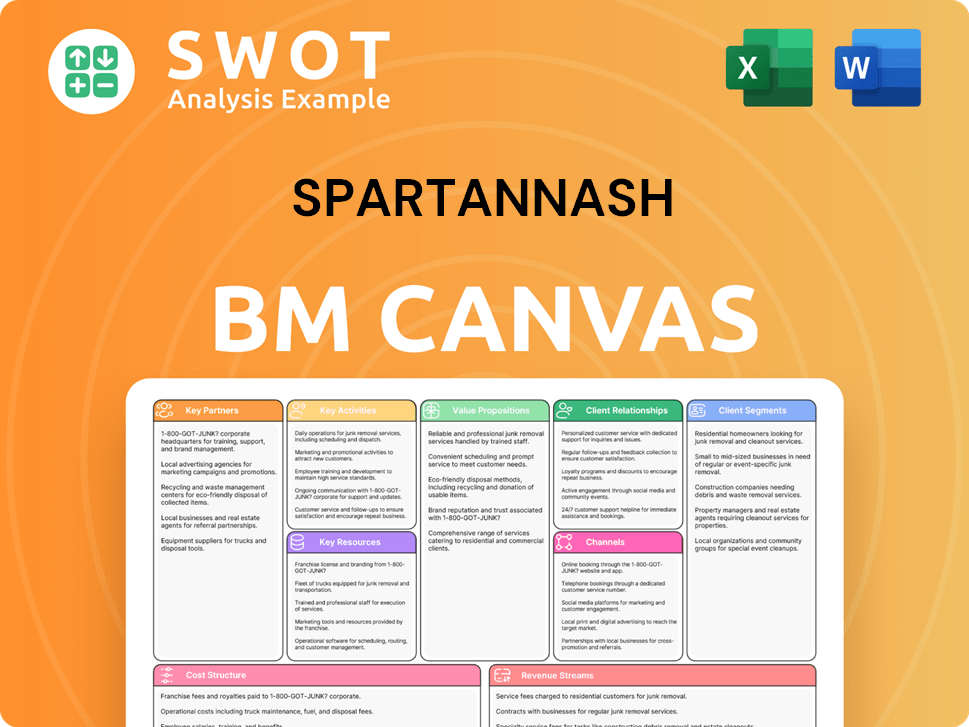
How Is SpartanNash Positioning Itself for Continued Success?
The SpartanNash Company holds a significant position within the U.S. food distribution and retail sectors. It competes with large national distributors and regional grocery chains, with a notable market share in the independent retail segment and military supply. Its success is underpinned by reliable service, competitive pricing, and a wide product assortment. Understanding how SpartanNash works involves recognizing its integrated business model, which spans distribution, retail, and military sales.
However, SpartanNash faces several risks. These include intense competition, potential supply chain disruptions, and evolving consumer preferences. Regulatory changes related to food safety or labor could also impact operations. The company's ability to adapt to these challenges is critical for its future performance. The company's financial health and operational strategies are frequently assessed by investors and industry analysts, with attention to metrics like revenue, profit margins, and market share. Recent data indicates that the food distribution industry is highly competitive, with companies constantly seeking ways to improve efficiency and customer service to maintain their competitive edge.
SpartanNash has a strong presence in both food distribution and retail. It serves independent retailers, national accounts, and the U.S. military. The company's distribution network is a key asset, enabling it to reach a wide range of customers. The company's focus on its core competencies and strategic initiatives are key to its market standing.
Key risks include competition, supply chain disruptions, and changing consumer behaviors. Economic downturns and inflation can also impact profitability. These risks are mitigated through strategic planning and operational efficiency. The company must adapt to evolving market conditions to maintain its competitive edge.
The future involves sustained efforts to leverage its integrated business model. Investments in technology and e-commerce are crucial. The company aims to expand its distribution network and strengthen relationships. The company's success will depend on its ability to adapt to technological advancements and industry changes.
The company is focused on enhancing operational efficiency through technology. It is also expanding its e-commerce capabilities to meet consumer demands. Furthermore, SpartanNash is committed to strengthening its relationships with suppliers and customers. These initiatives are designed to drive growth and profitability.
To ensure future growth, SpartanNash is focusing on several key strategies. These include enhancing its distribution network, expanding its e-commerce presence, and optimizing its retail operations. These initiatives aim to improve efficiency and customer satisfaction.
- Investing in technology to streamline operations and improve supply chain management.
- Expanding its distribution network to reach new markets and customers.
- Focusing on strategic acquisitions and partnerships to enhance its market position.
- Improving its e-commerce capabilities to meet the growing demand for online grocery shopping.
SpartanNash Porter's Five Forces Analysis
- Covers All 5 Competitive Forces in Detail
- Structured for Consultants, Students, and Founders
- 100% Editable in Microsoft Word & Excel
- Instant Digital Download – Use Immediately
- Compatible with Mac & PC – Fully Unlocked
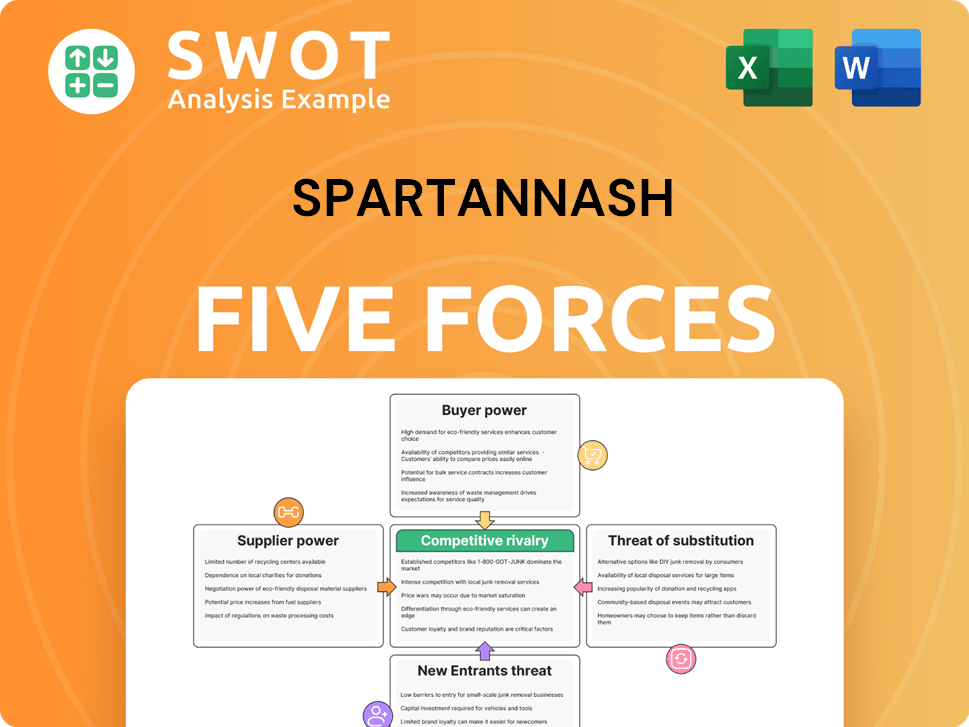
Related Blogs
- What are Mission Vision & Core Values of SpartanNash Company?
- What is Competitive Landscape of SpartanNash Company?
- What is Growth Strategy and Future Prospects of SpartanNash Company?
- What is Sales and Marketing Strategy of SpartanNash Company?
- What is Brief History of SpartanNash Company?
- Who Owns SpartanNash Company?
- What is Customer Demographics and Target Market of SpartanNash Company?
Disclaimer
All information, articles, and product details provided on this website are for general informational and educational purposes only. We do not claim any ownership over, nor do we intend to infringe upon, any trademarks, copyrights, logos, brand names, or other intellectual property mentioned or depicted on this site. Such intellectual property remains the property of its respective owners, and any references here are made solely for identification or informational purposes, without implying any affiliation, endorsement, or partnership.
We make no representations or warranties, express or implied, regarding the accuracy, completeness, or suitability of any content or products presented. Nothing on this website should be construed as legal, tax, investment, financial, medical, or other professional advice. In addition, no part of this site—including articles or product references—constitutes a solicitation, recommendation, endorsement, advertisement, or offer to buy or sell any securities, franchises, or other financial instruments, particularly in jurisdictions where such activity would be unlawful.
All content is of a general nature and may not address the specific circumstances of any individual or entity. It is not a substitute for professional advice or services. Any actions you take based on the information provided here are strictly at your own risk. You accept full responsibility for any decisions or outcomes arising from your use of this website and agree to release us from any liability in connection with your use of, or reliance upon, the content or products found herein.